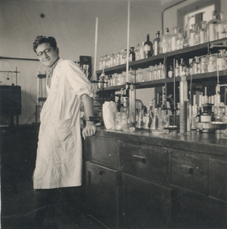Fifty years ago, a young Israeli scientist took part in the discovery of a chemical process that now forms the basis of multi-billion-dollar polymer and nanotechnology industries. And the discoverer? He still wears sneakers and shorts.
Polymers are molecular “trains” composed of identical small molecules, or “cars,” linked one after the other in a long chain. Creating a polymer, like writing a story, has three stages: beginning, middle (addition of molecules to the chain) and end (the end of production). Fifty years ago, Prof. (then Dr.) Moshe Levy, working in the laboratory of Prof. Michael Szwarc in the U.S., found a way to prevent the third stage from taking place – creating polymers that continue to grow longer, as long as they are supplied with new “cars.” Using the story-writing analogy, one could say that he managed to find a formula for creating a never-ending story.
The inventors called these chemical chains “living polymers.” One of their features was that all chains growing in the same system reached the same length. As the scientists could control this length by altering the building block supply, they were able to control the polymers’ physical properties. Over the course of the past fifty years, this discovery has turned into a fundamental principle underlying the plastics and synthetic rubber industries. It has also provided the momentum for developing macromolecular architectures and various nanotechnology applications.
Moshe Levy started out in 1946, working as a technician in the laboratory of Dr. Bruno Rosenfeld in what was then the Daniel Sieff Research Institute. Dr. Chaim Weizmann granted him an Institute scholarship to study at the Hebrew University of Jerusalem. However, Israel’s War of Independence broke out two months into his studies, and Levy was called to serve in the Haganah, the pre-state Jewish defense organization.
After the war, he completed his studies at the Hebrew University and transferred to the laboratory of Szwarc at the State University of New York at Syracuse, where he received his doctoral degree and went on to postdoctoral research. Szwarc, a winner of the prestigious Kyoto Prize and considered one of the greatest physical chemists of all times, had studied at the Hebrew University under Moshe Weizmann, Chaim Weizmann’s brother. Thus, Szwarc and Levy were both far from home when they first discovered the living polymers.
Levy decided to pack his belongings and go back to Israel. His work in the U.S. on living polymers was carried on by another Israeli – then postdoctoral fellow Dr. Joseph Jagur. Both scientists eventually joined the Weizmann Institute, where they carried on their research for many years.
Profs. Jagur and Levy, who have recently retired, still work in the Weizmann Institute’s Perlman Building, continuing to develop new ideas and carefully documenting the basic discoveries that have since become the province of industry. Jagur has written three books on this topic. The third, published several months ago, is dedicated entirely to living polymers and the magic of a never-ending story.
